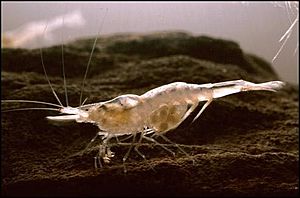Kentucky cave shrimp facts for kids
Quick facts for kids Kentucky cave shrimp |
|
|---|---|
 |
|
| Conservation status | |
| Scientific classification |
The Kentucky cave shrimp (Palaemonias ganteri) is a special kind of shrimp that lives only in caves. It has no eyes and is almost completely clear, so you can see right through it! This shrimp is known as a troglobite, which means it spends its entire life deep inside caves. It looks a lot like its close relative, the Alabama cave shrimp.
You can find the Kentucky cave shrimp only in underground streams within caves. These caves are located in the central Kentucky region, especially around Mammoth Cave National Park. The shrimp mostly eats tiny bits of sediment that get washed into the caves by groundwater.
Protecting the Kentucky Cave Shrimp
The Kentucky cave shrimp is a very rare animal. Because of its small numbers, it was listed as an endangered species in 1983. This means it needs special protection to survive. In 1994, it was also added to the IUCN Red List as endangered. There are only a few thousand of these unique shrimp left today.
Threats to the Shrimp's Survival
The biggest danger to the Kentucky cave shrimp is water pollution. When dirty water from outside the caves flows into their underground homes, it can harm or kill the shrimp. Some towns nearby do not have good systems to clean their sewage, which can lead to polluted water.
Other dangers include spills from traffic accidents or businesses near the caves. For example, in 1979, a pollution incident killed many cave animals in Mammoth Cave National Park. Another time, in 1980, a truck carrying dangerous chemicals overturned near the park. These events show how easily the shrimp's habitat can be damaged.
Helping the Shrimp Recover
To help the Kentucky cave shrimp survive, a special plan is in place. This plan includes several important steps:
- Finding out exactly where the shrimp live and how much space they need.
- Studying the shrimp's life to understand what they need to have healthy populations.
- Keeping an eye on how many shrimp there are and if their numbers are growing.
- Making sure the water in the caves stays clean and safe.
- Protecting the shrimp from any new animals that might try to eat them.
- Teaching people about the Kentucky cave shrimp and why it's important to protect them.
By following these steps, scientists and conservationists hope to help the Kentucky cave shrimp thrive for many years to come.


